Preface
Does the line of authority exist in yoga transmission? Is there
such thing as «classic» yoga? I don’t think so. Such a view reminds
me the times we were kids and believed in wise old guys who have
all the answers, you just have to ask them well… Besides such a point
of view is philosophically inconsistent. Where would those «guys» get
that knowledge? Should we refer to extraterrestrials? Then how did
they invent yoga?
No, at the heart of any esoteric tradition stand some real peo-
ple, who by an inconceivable act of spiritual enlightenment have seen
further than others. Sometimes their disciples kept their teaching on,
climbing higher and higher, although more often they just used this
teaching or turned it into a cult. Many great teachings degenerated
into religions. Unfortunately it’s much easier to worship than to think
and to create…
Esoteric knowledge has another distinctive feature. It cannot be
transmitted without personal practice. It is «hidden» not just because
someone is hiding it (although it’s also true) — you can’t conceive it
without making radical changes in yourself. Esoteric knowledge can-
not be KNOWN. It can only be LIVED. Otherwise it makes no sense.
The understanding of every new level is possible only after the previ-
ous one is passed. It is not an act of learning, but our personal mys-
tical experience. Esoteric knowledge cannot be transmitted in a form
of scripts and tables. It must be given from the teacher to a student.
The Teacher must have patience and wish to lighten fire of spirit in
his student, and the student must be ready and willing to become a
co-creator of himself. A Chinese martial tradition has a saying: «There
is no style — just Master’s personal technique». Restating this maxim
we can say: «There is no classic yoga — just Teacher’s personal yoga».
It works in his hands and helps his students to change and to create
their own Yoga, which stops being yoga, a method, if canonized. An
esoteric teaching is inseparable from its bearer and its Teacher. While
only Life can prove, if the teaching is effective and right.
Did objects and methods of yoga change through the centuries of
its existence? The answer comes logically from the aforesaid: yes, con-
stantly. But in details. Different times and different people need dif-
ferent words and methods. But the said above object is always there.
The changing of a status can also be different. As well as the levels of
Teachers.
So yoga is not a religion. Living «here and now» is not less im-
portant for a yogi than his spiritual tasks. That is why along with the
Big Yoga, setting its higher aims there’s always been the Small Yoga —
a system of methods (once again — methods), aimed at life improve-
ment: health, wealth, emotional state. At that the Small Yoga practice is
not a diversion from the Spiritual Way, but its essential element.
13
. SAFRONOV. Yoga: Physiology, Psychosomatics, Bioenergetics
Yoga is not a practice of asceticism. For a harmonic and creative
existence you need to love life. Although elements of ascetic practices
can be used as one of the methods.
Yoga is not a philosophy, but it has philosophic basics and meth-
ods based on philosophic practice. Over years yoga repeatedly changed
its philosophies (plural), explaining the same practices in different
words.
Yoga is not an ethic system. Every ethic system is in the long run
engendered by the religious perception of the world, by the fear of pun-
ishment, by the supreme forces etc. Yoga has its rules too ( Yama, for
example), which can be mistaken for ethical, but their essence is princi-
pally different. Yogi follows these rules not because he is afraid of pun-
ishment — it is his most pragmatic choice allowing him to save energy
as much as possible. On the higher levels all rules disappear and give
way to the principles.
Understanding of principles is the primary perceptive object of
yoga. The comprehension of yoga principles is the objective of this
book.
14
Hatha in the system
of Yoga
Al the methods of Hatha Yoga are meant for gaining success
in the Raja-Yoga.
Hatha Yoga Pradipika
Practically in every esoteric teaching there was a special system
assigned to work with the physical body — one of the differences be-
tween esotericism and religion. Gymnastics of Hermes, wushu, styles
of Qigong, whirling dervishes, Zikri, Zongshen — the gymnastics1 of
Vietnamese monachs, breathing practices of Hesychasts and so on. Al-
though the most developed and sophisticated, as well as probably the
most ancient of them is Hatha yoga.
What is the sense of work with the physical body within an eso-
teric tradition? Just to strengthen it in order to prepare for more diffi-
cult psychical exercises? Maybe, but then you don’t need such refined
exercises. The ordinary gymnastics, invented by Greeks (almost all na-
tions had its analogues), perfectly strengthens our body. Healing the
body? Indeed yoga has its therapeutic effect, but not as a chief aim.
Already many centuries ago yoga was said to be for strong and healthy
people. Not to mention that medical treatment (Tibetan medicine) gives
outstanding results and demands from patient much less efforts. Maybe
its objective is to attain extraordinary physical capacities: force, flexibil-
ity, stamina? Nonsense, of course, if you are not going to make a career
as a circus acrobat… Then what is the sense of physical training within
esoteric traditions? What is the most important for us, what is the sense
of Hatha?
To answer this question let’s remember that yoga is a system,
aimed at the conscious changing of a person, at the self-change, con-
scious restructuring of our psyche, of our subtle bodies. But human’s
psyche is difficult to study — to say nothing about our subtle bodies,
even more difficult to work with, because a common person cannot
see them. This is when we can use the connection between our phys-
ical body and our subtle bodies along with our psyche. Our physical
body becomes a clue to all the processes that take place in our sub-
tler bodies.
1 I conventionally call it «gymnastics», for the lack of more appropriate term. In fact all the
listed techniques are fund mentally differ (even in the way of looking) from what Greeks
used to call «gymnastics».
15
. SAFRONOV. Yoga: Physiology, Psychosomatics, Bioenergetics
Indeed our physical body is the reflection of our subtle bodies.
Whatever is below is similar to that which is above. But unlike subtle
bodies, our physical body can be touched and seen. All processes hap-
pening in our subtle bodies are reflected in our physical body. So that
all possible problems of our psyche, of our ether and astral bodies are
reflected in the stature of our physical body in the form of physical con-
straints: contractions, curvatures of the spine — they show our state of
chakral system and in the limit — our diseases1.
The contrary is also true: by influencing our body, we influence
our psyche. That’s what Hatha is about, that was its place and objective
in the system of Yoga.
Do the objectives of yoga change? I think we can definitely an-
swer «yes». Psychologically a modern European is completely different
from a Hindu. We are people «living by our head», while Hindu were
to greater extent sensitive, living mostly by their feelings and emotions.
This makes our ways to the spiritual harmony different: for Hindu this
way had to do with the «lifting» the energy (here’s where Kundalini
comes from), while for us it is putting it down, developing our physical
sensitivity.
That is why using Indian practices automatically, without adapt-
ing them to our modern cultural and historic conditions is a false way,
leading away from the harmony and turning yoga itself — an excep-
tionally rational and pragmatic system — into a religion.
1 For more details and schemes of this correspond nce see my book «Psychodiagnostics of
Chakras».
16
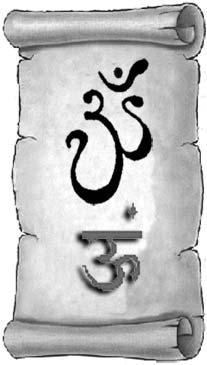
HUMAN ENERGY STRUCTURE
Energy bodies
Nearly all esoteric systems believe that a person, beside a physical
body, has the so-called «fine» bodies: seven bodies, four of which are
the brightest, while the others remain so fine that it is hard to notice
them in our everyday life.
Etheric body (Sanskrit: Prana Kosha, sheath made of prana) in
other schools also called vital body, which defines the structure of hu-
man health. If you have a cut or a scratch, ultimately your skin heals
–regeneration program is defined by our etheric body. The stronger it
is, the healthier you are, and the weaker, the more valetudinarian you
are. The etheric body has the form of our physical body. There is also
an etheric field. It’s our etheric energy, not structured in the etheric
body and surrounding us as a bag of 0.4–1 m (for the healthy person).
Etheric field stands in a dynamic balance with the etheric body. Our
etheric body rarely changes its form, normally when we become seri-
ously ill. When we have a lot of energy: we ate a lot, energetically
nibbled someone (it also happens), stayed in some places with a lot of
etheric energy, all the extra energy goes to the etheric field, making it
bigger. In special cases etheric field can widen up to 1,5–2 meters, it
can be very big, but not for a long time. If someone has a lot of etheric
field energy, ultimately he’ll be «eaten around», because one cannot
carry along a lot of energy. When we speak about human aura and
the size of its field, we mean etheric field.
Only living objects, including minerals, have an etheric field. By
definition it’s a non-physical field, so any attempts to measure it by
physical devices are insensate. It can only be measured by devices us-
ing living objects: germs, plants, animals, people and their reaction on
the energy. The most common way of measuring etheric field is biolo-
cation. The etheric field as well as the etheric body can be seen on the
homogeneous background, but it is more rarefied.
Astral body (Sanskrit: Koma Kosha — sheath of desires) defines
the structure of our etheric body. If etheric body destabilises, the as-
tral body gives a regeneration program. Astral body repeats the out-
line of our etheric and physical bodies and is situated outside the
etheric body. It also can be seen on the homogeneous background.
17
. Safronov. Yoga: Physiology, Psychosomatics, Bioenergetics
Astral body defines our emotional state. Astral field is a volume of
the astral energy, which is in dynamic balance with the astral body.
If we say: «What a charismatic person!» we react on an astral field.
A person with a strong astral field can influence other peoples’ emo-
tions. Sociology and psychology call it charisma. Being close to such
a person it’s easy to get involved in his emotional state.
To feel astral energies one needs no special skills. In the society
you feel that the ambience is distressing, at this point you»ve switched
to the feeling of astral energies of this company. If you feel that the at-
mosphere is joyful and you have fun, you’re feeling these energies this
way. The capacity to switch to surrounding astral energies and get-
ting these states on the conscious level is the «exiting to astral».
Of course astral fields cannot be measured by physical instru-
ments either.
Mental body (Sanskrit: Mana Kosha — sheath of mind, manasa) is
ideas, thoughts, knowledge, and senses.
Discussion of higher planes and fields is above the theme of this
book.
Human’s Сhakral System
History
The main element of human energy structure is chakral system.
Chakras (Sanskrit: Chakra — wheel or disc) are mentioned in the most
part of Yoga and Tantra origins, such as «Gheranda samhita», «Hatha
Yoga Pradipika», «Shiva samhita», «Shat Chakra nirupane», «Yoga Tat-
tva Upanishada», «Amritabindu Upanishada» and many others (see
Appendix 2).
Chakras are also mentioned in Tibetan origins such as in the fa-
mous Atlas of Tibetan medicine, in Chinese treatises of Neidan (Sanskrit:
neidan — inner elixir). Some elements of chakral system are mentioned
in Japanese martial arts (hara, ten-sho), in outlooks of Mesoamerican
shamans. These notions are also met in less developed systems (natu-
rally, in simplified version).
The Western world1 learned about chakras thanks to the proceed-
ings of Arthur Avalon, a European who got into the restricted Indian
Tantric School and afterwards has published notions he received. He
was the first to publish classical Indian drawings of chakras, which
have been redrawn for last 100 years by other authors with all imagin-
1 General public. Alchemists and representatives of other esoteric systems in Europe has
known about chakral system before.
18
Human Energy Structure
able errors and distortions. He also gave mantras for chakras and their
petals, correlated petals with human qualities. Based on his chakral
scheme a countless number of schools and interpretations were born,
as well as various techniques of work with chakras. Although being
an adept of an esoteric school, Avalon made some hay of understand-
ing chakral system, affirming that one can open chakras by «raising
Kundalini», while an common person has all chakras closed.
The next step in understanding the chakral system in modern
occult tradition was made by Rudolph Steiner, the founder of anthro-
posophist society. He noticed that chakras don’t open while raising
Kundalini, on the contrary: people open their chakras, acquiring some
qualities and skills, which creates prerequisites for raising Kundalini.
Thanks to Steiner’s observation the concept of chakral system in modern
esotericism has broadened. In Steiner’s works he affirms that all people
have chakras, but their level of development can differ. Moreover the
chakra’s characteristics define our actions, capacities and personality.
At the same time psychology also approached the problem of
chakral system.
Wilhelm Reich further acknowledged as a founder of the body
psychotherapy has found out that psychological problems lead to
muscle blocks, localising as seven «muscle armours», each of them
reflecting a certain well-defined group of problems. (I suppose, that
even those readers who don’t know about works of Reich have al-
ready guessed that position and characteristics of these «armours»
amazingly reminded Steiner’s chakral system). This theory was sig-
nificantly developed by progenies and followers of Reich (A. Lowen,
Feldenkreiz), while body-psychotherapy has taken a fare place among
other therapeutic systems. The Western world was finding its first
clues.
A certain input in understanding the chakral system and its role
in studying human body was done by mediums in the period of great
interest to the extrasensory capacities in the late 1970s. Mostly inde-
pendently from the mentioned origins based on their personal expe-
rience, mediums noticed that human body has energy centres and a
man’s health depends on their state. These centres are located practi-
cally in the same place as Avalon’s lotuses.
However no wonder all the systems independently were com-
ing to the same conclusions. Chakras exist in reality and any studying
of a human being ultimately leads to similar notions. The connection
between emotional states and certain parts of body is also reflected in
such metaphors as «to have a clear head», «a thick-headed person»,
«lump in one’s throat», «a heart withered», «to be a pain in the neck»,
«a great weight off one’s mind», «a sinking sensation in the pit of
one’s stomach», «ants in one’s pants», «a pain in the ass».
19
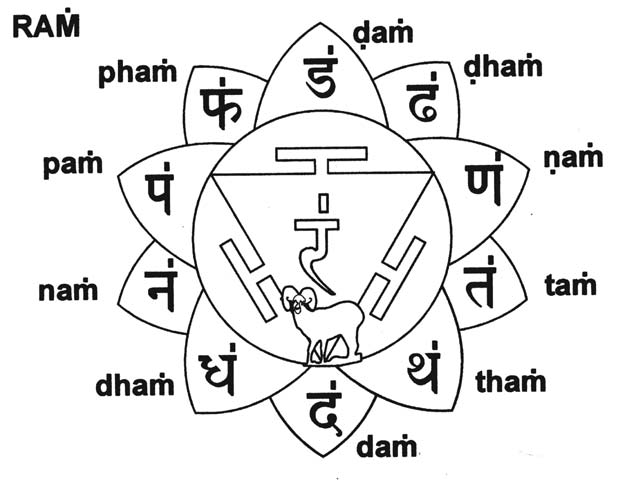
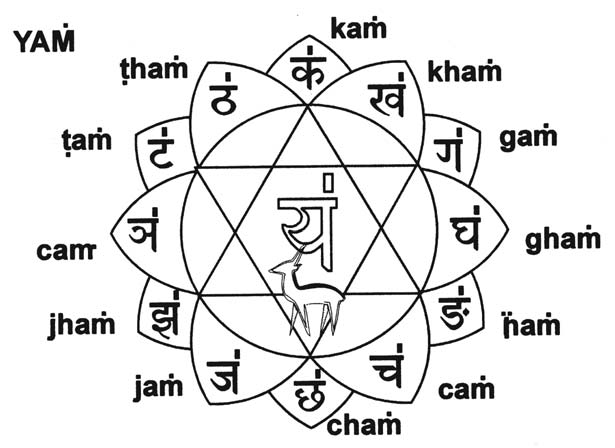
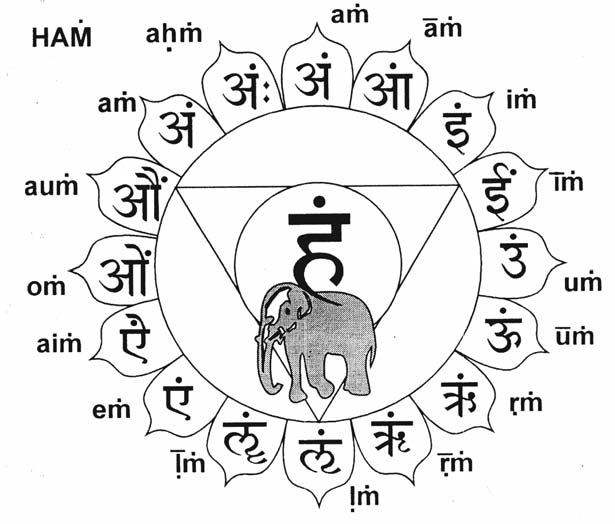
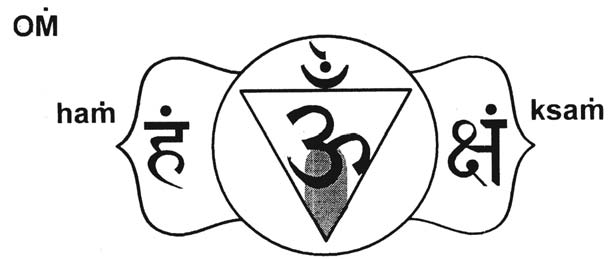
. Safronov. Yoga: Physiology, Psychosomatics, Bioenergetics
Physiological aspects of chakras
Let’s briefly describe the localisation and symbols of chakras ac-
cording to the Indian tradition.
SAHASRARA is located in the crown of the head. Its exact sym-
bol is unknown.
AJNA is located between eye-
brows and relates to the pineal gland.
Anatomically relates to the brain,
eyes, frontal and maxillary sinuses,
nose, and upper teeth.
VISHUDDHA
is
located
around the throat and relates to the
thyroid and parathyroid gland, ears
and everything in the larynx, with
gullet, trachea, upper bronchus,
tongue and cervical vertebra.
ANAHATA, a heart chakra.
Controls
cardiovascular
system,
mainly the heart itself, lungs, thoracic
vertebra, arms, ribs and all intercos-
tal spaces, inferior bronchus.
MANIPURA is located slightly
over the navel and relates to the fol-
lowing organs: stomach, gastrointes-
tinal tract (except the upper gullet),
intestines, first of all with the small
intestine (colon is more related to the
Muladhara), upper kidneys and adre-
nals (adrenalin is a hormone of Ma-
nipura), liver, spleen, vertebra in the
Manipura region, pancreas.
20
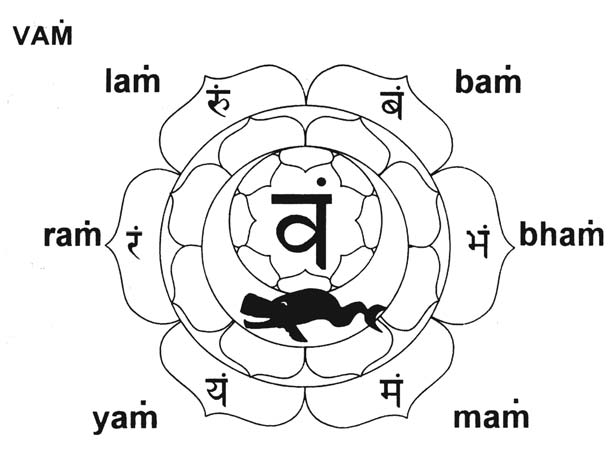

Human Energy Structure
SVADHISTHANA is located
in genitals, about 4 fingers down the
navel. Related to the genitals (male
and female), bladder, inferior kid-
neys, renal pelvises, ureters, urinifer-
ous tubule (for women), lower back
(except the sacrum, related to Mulad-
hara), hips.
MULADHARA is located in
the sacrum. It relates to the sacrum,
prostate, pelvis, colon, rectum.
Chakras exist on the astral, etheric and physical planes. Correlating
their localisation with endocrine glands and with the knots of autonomic
nervous system (ANS) we can easily see the perfect analogy. This connec-
tion is absolute most of all, if you take into account additional chakras
(4 for each primary chakra), mentioned in the Atlas of Tibetan Medicine.
Physically every chakra is presented by a gland or an ANS node.
Nevertheless people are not just physics. That is why the chakral
system is not limited by the particularities of our physical body.
Chakra’s characteristics are directly related to the human energy and
psyche. As a matter of fact chakras are «a bridge», connecting our phys-
ical, etheric and astral bodies.
Psychological aspects of chakras
Chakra is a complicated notion with many parameters. They are
often described from just one point of view. For example, saying it’s
strong or weak. Actually to describe chakra you need at least ten differ-
ent parameters. Some of them are given below.
Chakra’s strength
Chakra’s strength is a volume of energy, initially present in a
chakra, while its weakness is the absence of this energy. The energy
in chakra determines our desires, and the more energy we have, the
stronger our desires are. This fact explains the esoteric principle; if you
listen to your real desires, you follow your dharma.
21
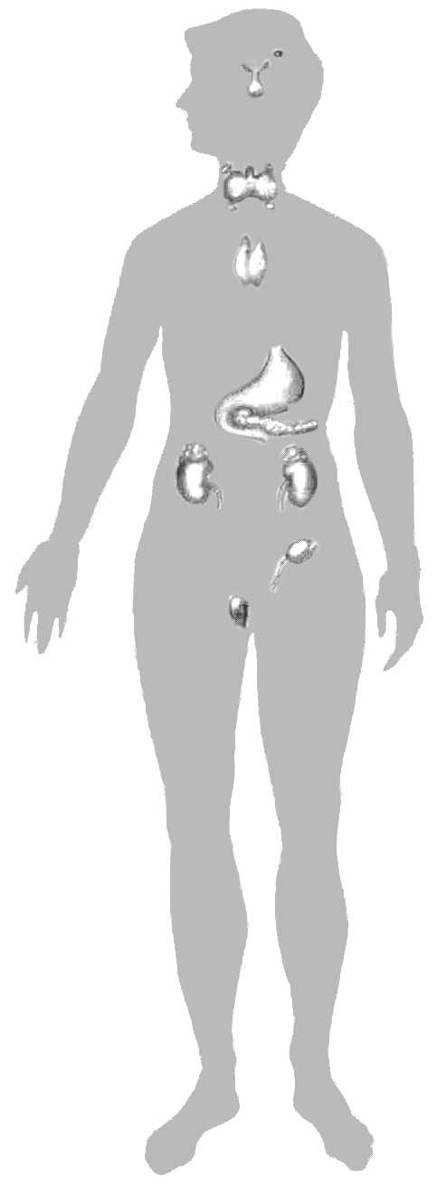
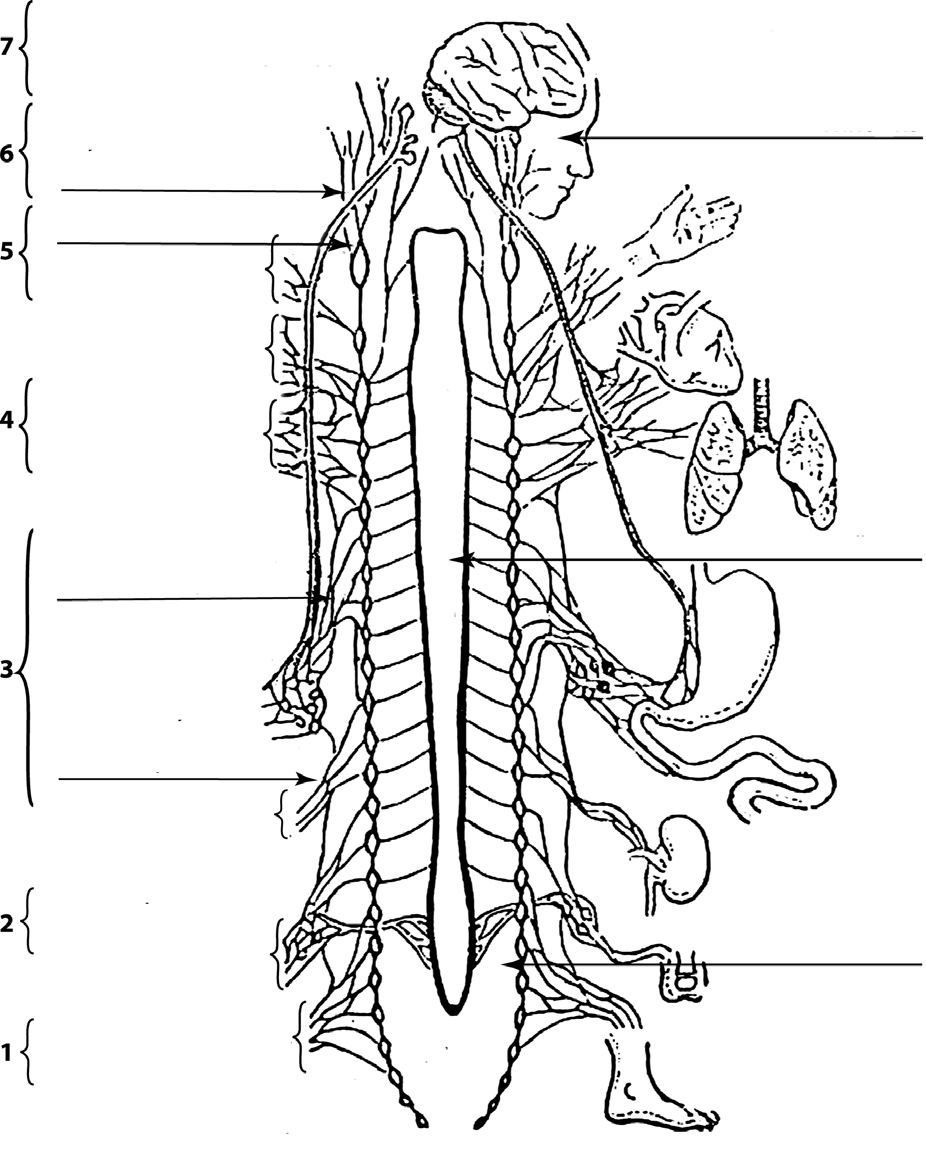
. Safronov. Yoga: Physiology, Psychosomatics, Bioenergetics
PICTURE 1. Endocrine glands
1 — pineal gland; 2 — epiphysis;
3 — pituitary gland;
4 — parathyroid gland;
5 — thyroid gland;
6 — thymus; 7 — pancreas;
8 — adrenal gland;
9 — ovary; 10 — testis.
head, brain
pineal gland
vagus nerve
superior cervical
ganglion
neck
thoracic
limb
heart,
lungs
great
splanchnic
nerve
medulla
solar plexus
intestines,
stomach
small splanchnic
nerve
kidney
superior mesenteric
ganglion,
pelvic nerve
sexual organs
PICTURE 2. Ganglia of ANS
lower limb,
and their correlation with
external genitalia
chakras
From all above said it is easy to understand that a person with a
strong chakra is highly motivated by needs related to this chakra; so
we can make a psychological portrait of people with different strong
chakras. For instance a person with strong Muladhara works for pros-
perity, routinely organizes his private space and is ne












